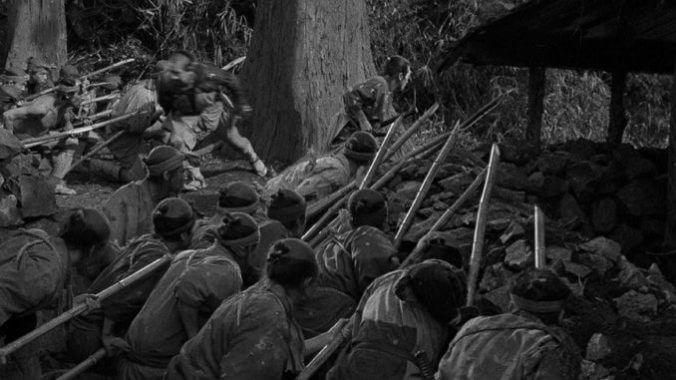
Akira Kurosawa is frequently referred to as “Emperor”—hyperbolic, sure, but when it comes to the director’s staggeringly influential, detailed and versatile body of work, the truth catches up to the legend. Ranking his movies comes with this burden. Pick practically any Kurosawa movie at random, and within you’ll see the blueprints of genres and styles that have become touchstones of world cinema, from Spaghetti western, to police procedural, to art house drama with a non-linear narrative—the list is tangled and endless.
As hopefully a service to Kurosawa beginners who would love to know which films they should check out first, then move their way down in order to become completionists, we’ve decided to rank all 30 feature films the Emperor has helmed. Three movies are excluded from this list: The TV documentary Song of the Horse, mainly because of the genre and the medium, and two features, Uma and Those Who Make Tomorrow, where he stepped in to direct small sections of each film at the behest of the studio.
Here is every Akira Kurosawa movie, ranked:
30. Sanshiro Sugata Part Two (1945)
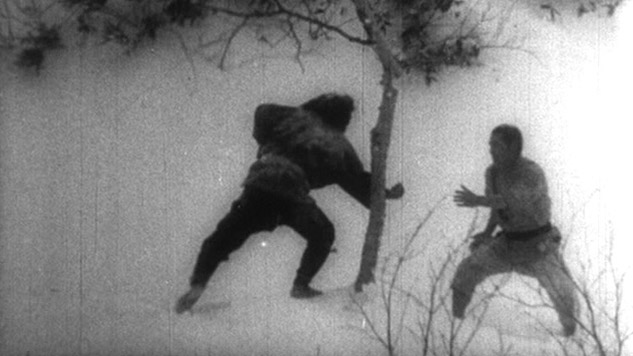
Kurosawa didn’t want to direct this slapdash follow-up to his first feature, Sanshiro Sugata, which continues the adventures of the title character, a legendary Judo master (Susumu Fujita). His disinterest is on full display: His direction is uncharacteristically dull and flat. Even with films in which we know (or can tell) the director wasn’t all that emotionally connected to the material, Kurosawa manages to wrangle together a sequence of two that stands out as unique, groundbreaking even. That’s not the case with Sanshiro Sugata Part Two. Check the finale, steeped in one Kurosawa’s favorite visual themes—man vs. nature—which just looks like lazy soundstage work.
29. The Most Beautiful (1944)

As the rare individualist in Japanese cinema, Kurosawa wasn’t necessarily swept up in patriotic fervor during World War II, and mainly managed to stay away from helming propaganda films designed to reignite the Japanese passion for victory, especially during the final years of the war when morale was at an all time low. Still, Kurosawa relented once: The Most Beautiful, an unfortunately sappy melodrama about a group of girls who work for a factory that manufactures lenses for weapons, striving to do the best job possible in order to help the war effort. Nowadays, the film’s lack of objective truth—a rarity in Kurosawa’s cinema as far as his aspirations toward exploring the inherent falsity of subjectivity goes—makes The Most Beautiful an important time capsule piece, and little else. For Kurosawa, however, it was always special: On the production of this film he met his wife, who spent the rest of her life with the director until her passing in 1985.
28. The Men Who Tread on the Tiger’s Tail (1945)

During the final days of World War II, production funds for Japanese films were at a bare minimum. As a way to keep working, Kurosawa and his crew slapped together a 60-minute period drama they could shoot entirely on one soundstage. Kurosawa wrote the screenplay in one day—and it shows. The simple story of Japanese soldiers attempting to get through an enemy blockade by pretending to be monks could have made an amusing short, but it drags even in its barely feature-length form. Still, The Men Who Tread on the Tiger’s Tail is notable as the first collaboration between Kurosawa and Takashi Shimura, one of his regulars.
27. Sanshiro Sugata (1943)
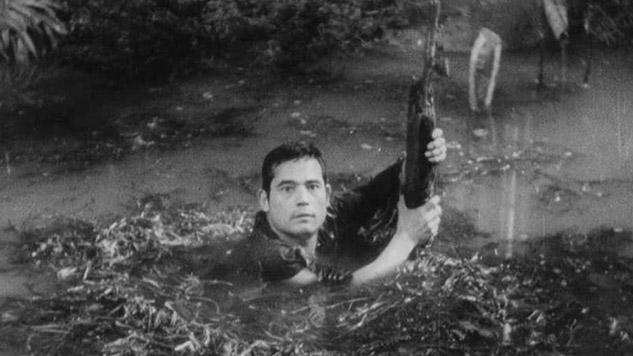
Kurasawa was obsessed with making sure that a film adaptation of the popular novel with the same name, about the hardships that a Judo fighter (Susumu Fujita) goes through in order to become one of the greatest in his field, would be his first feature. He got his wish, and considering the visual language and themes that would dominate his later work, this wish makes sense. The story is a bastion of one of Kurosawa’s characteristic premises: A dedicated individual fights against his nature, figuratively and literally, for what he believes. As admirable as Sanshiro Sugata is, this feature debut still carries some freshman missteps, such as awkward pacing and some odd framing choices. However, getting through the growing pains is all worth it to experience Kurosawa’s lush finale, a first showcase for Kurosawa’s delicate visual relationship with the natural environment.
26. The Idiot (1951)

If John Ford provided the inspiration for Kurosawa’s action/adventure side, Fyodor Dostoyevsky was his main influence when it came to executing dramas. Therefore, at least on paper, it makes perfect sense for Kurosawa to adapt one of the literary master’s best-known works. Unfortunately, the four-and-a-half hour final cut of the film was mercilessly slashed by his studio, Toho, by a whopping two hours. This led to an almost unintelligible narrative that relied heavily on title cards to gap the story holes that were left behind. What we end up with is a passionate but uneven adaptation, but the sumptuous way the film captures the gorgeous Hokkaido locations covered in snow is a major reason to at least check out The Idiot once.
25. The Quiet Duel (1949)

The Quiet Duel, a pretty heavy-handed melodrama about a doctor (Toshiro Mifune) who accidentally contracts syphilis and struggles to maintain his career while making sure he never infects anyone, was based on a play. This becomes obvious, since most of the film takes place in small soundstage locations, relying on performances over any sort of visual style. Thankfully we have the trademark intensity projected by Mifune: Kurosawa regular, muse, spiritual counterpart.
24. No Regrets for My Youth (1946)
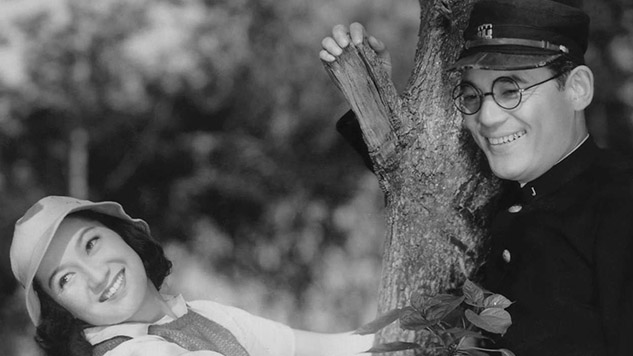
The end of World War II perhaps compelled Kurosawa to meditate on the aftermath of the conflict, and how the resulting political chaos in Japan would affect the lives of the generation to come. Thus, he directed No Regrets for My Youth, a politically charged drama about an idealist young girl (Yasujiro Ozu regular Setsuko Hara appearing in her only Kurosawa film) struggling to regain her idealism and identity after her family is accused of harboring anti-Japanese sentiments during the days leading to the beginning of the war. Kurosawa constructs a tightly wound narrative, propped up immensely by Hara’s unique talent for balancing deep emotional vulnerability with a character’s core strengths. Yet the film might be a bit confusing for Western audiences—even contemporary Japanese ones—since it delves heavily and specifically into the politics and mood of the treacherous post-war period.
23. Scandal (1950)
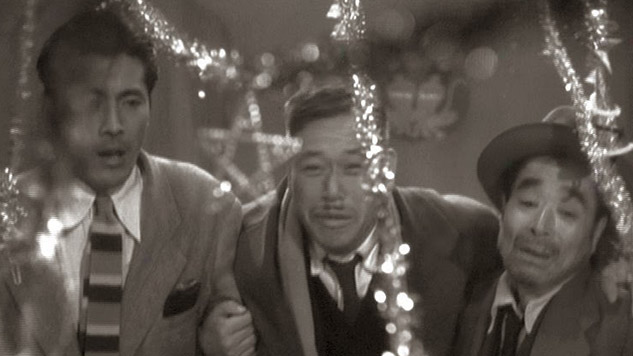
Kurosawa’s filmography is full of stories ahead of their time—in the case of Scandal, Kurosawa points some searing criticism towards the moral bankruptcy of tabloid journalism, and by extension the cult of celebrity. For the first half of his film, Kurosawa focuses on how a lack of respect for privacy, even when it revolves around a major celebrity played by Toshiro Mifune accompanied by his natural charm, can destroy lives. This focus then atonally shifts to a Frank Capra send-up, as a photographer (Takashi Shimura) who took the picture that disrupts the celebrity’s life begins to demonstrate some serious remorse for his actions. Kurosawa’s deeply empathetic and humanist sensibilities make him a perfect specimen to take on Capra, but this approach doesn’t meld with the strict anti-media satire that dominates a chunk of the film.
22. Rhapsody in August (1991)
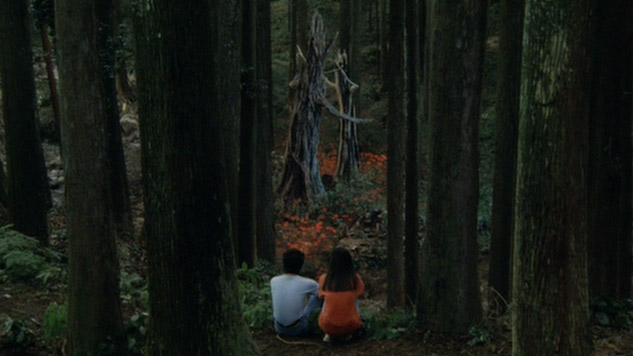
Kurosawa had tackled the immediate reaction of fear, dread and paranoia to the horrific bombing of Hiroshima and Nagasaki with I Live in Fear (see below), but Rhapsody in August is the calmer, almost Zen-like examination of the stains the attack left on the Japanese culture, decades after the fact. This is the kind of slow, introspective film a master produces during the twilight of his career (Kurosawa was 81 years old when he made it, and it was his second-to-last feature), so it might not be the best entry point for newcomers who are looking for the energetic Jidaigeki (period pieces) output for which he’s mostly known. Also, casting Richard Gere as a half-Japanese character was a bit of a misstep. As eager as Gere was to work with Kurosawa, he comes across as stiff and uncomfortable, perhaps because he had to learn his Japanese lines phonetically.
21. I Live in Fear (1955)
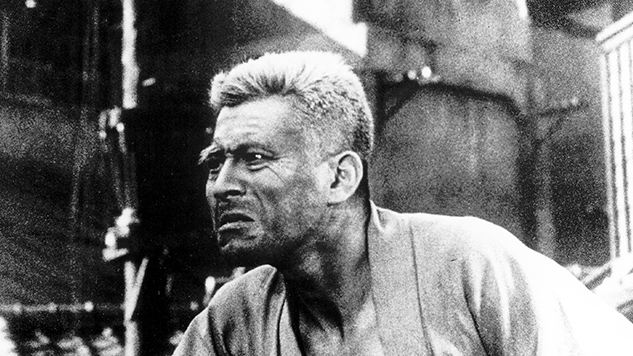
From a delicate study about the nuclear attack with the advantage of decades worth of hindsight behind it, we move immediately to a feverish drama that bluntly forces its Japanese audience to face the inherent sense of impending terror—waiting for the other shoe to drop, so to speak—they’d inherited from the end of World War II. As a kooky septuagenarian who’s obsessed with taking his family to South America before the next apocalyptic attack he’s determined is coming, Toshiro Mifune performs a neck-snapping 180 from his boisterous turn as Kikujiro in Seven Samurai, released just a year before I Live in Fear. A side-by-side comparison of his frail and vulnerable performance here to Kikujiro is all the proof one needs to show just how versatile and fearless of an actor this legend was. Kurosawa and Mifune use the old man’s insanity as a mirror held up to Japan’s post-war neuroses: Is it time to find a way to move on, or wallow in our desperation and possibly lose our collective minds in the process? As hard as the film pushes that question, Kurosawa acknowledges how tough it might be to get on with life after such trauma, evidenced by the film’s haunting final shot.
20. The Lower Depths (1957)
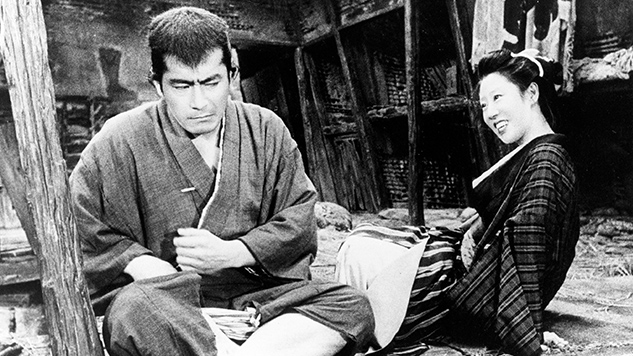
Thanks to his delicate eye for striking set design and ability to cast the best of the best, Kurosawa expertly adapts Maxim Gorky’s single-location play, managing to compellingly dramatize the day-to-day struggles of a small group of down-on-their-luck residents of a Japanese slum. The Lower Depths finds the thin line between staying true to the deeply Russian spirit of the source material and appealing directly to the Japanese culture of the late ’50s. Kurosawa employs a drab and straightforward tonal and visual approach to the way he examines these deeply flawed, yet intrinsically hopeful, characters, almost as a personal nod to Italian neorealism. (If you’d like a French take on this play, you can also check out the equally satisfying 1936 Jean Renoir adaptation.)
19. Dodes’ka-den (1970)

Just like The Lower Depths, Dodes’ka-den examines the fractured and desperate lives of a group of beggars living in a Tokyo slum, yet that’s where the tonal, stylistic and narrative similarities end. As opposed to the black-and-white bareness of The Lower Depths, Dodes’ka-den is a whimsical, borderline-abstract tale of hope and the importance of dreaming for a better life, even after hitting rock bottom. With his first color film, Kurosawa indulges in his past as a painter, literally covering each frame of Dodes’ka-den in bright, exuberant colors that contrast and copes with the dreary reality of its setting. For both Kurosawa newcomers and die-hard fans, Dodes’ka-den is a bit of an odd duck, a rare stream-of-consciousness work from a director who’s known for his narrative meticulousness—which is of course what makes it so special. Tragically, its box-office and critical failure also resulted in Kurosawa’s—thankfully unsuccessful—suicide attempt.
18. Dersu Uzala (1975)
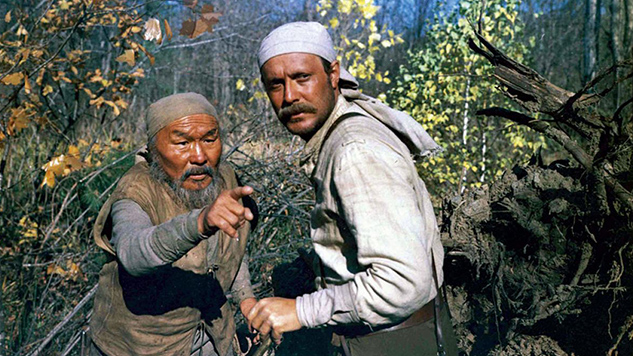
The early-to-mid ’70s was a rough time for Kurosawa. After the financial failure of Dodes’ka-den and his subsequent suicidal depression, he saw one project after the other crash and burn, mainly due to his name no longer drawing the box office numbers it once did. Relegated to directing commercials and other odd projects to get by, he had to look for help from other countries, and Russia was eager to pick up what Japan had so discourteously dropped. A direct adaptation of Vladimir Arsenev’s respected novel, with Russian actors and a Russian crew, might come across as a gun-for-hire situation for Kurosawa, but he had been working to make this adaptation a reality since the 1950s. Which makes sense, since the novel’s focus on man’s relationship to nature (and, in turn, our relationship to one another as reflected through nature( is all Kurosawa. Gorgeously shot, this slow-burn drama with a fairly simple narrative at its center—the friendship between a Russian army explorer (Yuriy Solomin) and his down-to-earth guide (Maksim Munzuk)—characterizes Kurosawa’s more contemplative late career work.
17. One Wonderful Sunday (1947)

One of the most underrated works in the master’s filmography, One Wonderful Sunday is the simple yet emotionally impactful story of a poor young couple (Isao Numasaki and Chieko Nakakita) trying to have a good time on their day off despite being dead broke and living in the wreckage of the nuclear attacks.. The natural chemistry between Numasaki and Nakakita is undeniable, and Kurosawa’s tightrope act between melodrama and comedy is admirable, especially considering One Wonderful Sunday is one of his earlier features. With such a narratively uncomplex, yet deeply character-oriented story, Kurosawa almost captures the tone of the modern American indie five decades before its inception. It’s not hard to imagine the likes of Richard Linklater or Jim Jarmusch tackling a remake.
16. Drunken Angel (1948)

Not only does Drunken Angel mark the first time two of Kurosawa’s legendary actors (Toshiro Mifune and Takashi Shimura) burn up the screen together with their trademark intensity, or mark the first of many celebrated collaborations between Mifune and Kurosawa, it’s also the film that Kurosawa considers to be his first great feature, since Toho Studios finally gave him complete freedom to achieve his vision. After all that hype, do we end up with a timeless masterpiece? Not really; instead Drunken Angel is a rock solid melodrama, the somber story of an alcoholic doctor (Shimura) trying futilely to rehabilitate a sick gangster (Mifune) as a way to atone for his own sins. The films drips with empathy, capturing real-life working class Tokyo right after the War.
15. Madadayo (1993)
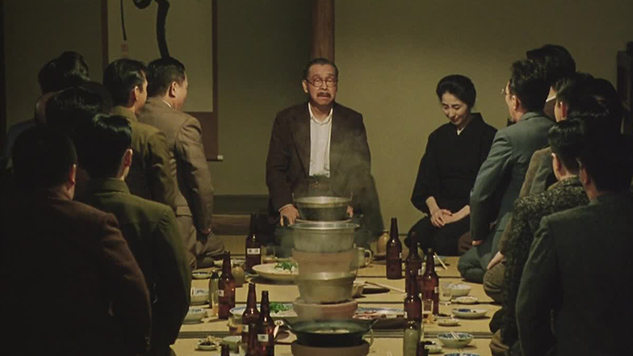
Kurosawa’s swan song is a lighthearted biographical drama about beloved teacher’s (Tatsuo Matsumura) relationship with his students across the rather tumultuous decades Japan endured throughout the mid-20th Century. Like Rhapsody in August, this tender film reflects an emotionally self-connected director perhaps knowing he was at the end of his career. The teacher at the center of the story is gentle enough to mourn the disappearance of his cat, yet tough enough to mold his pupils to face the unpredictability and harshness of adult life. It’s almost as if Kurosawa’s final message, maybe sensing that Madadayo was going to be his last film, is that both sentiments can coexist within the same body. So he goes out on one of his most striking final images, leaving us to ponder the importance of what others might find mundane or insignificant.
14. Sanjuro (1962)
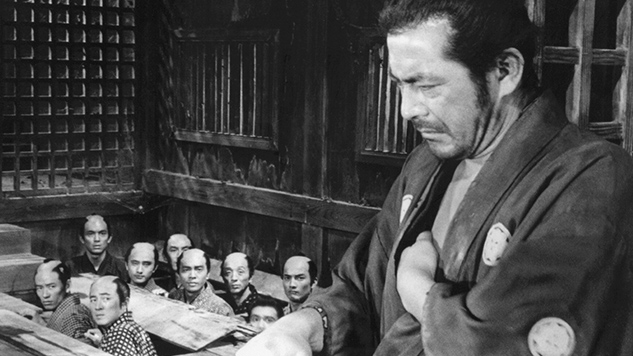
Sanjuro is not as well known, and perhaps not as great, as its predecessor, the spectacular tale of anti-hero western badassery known as Yojimbo, but considering that the latter is a genre-defining masterpiece that had a big hand in molding our modern action hero archetype, it’s a fairly tall order to expect the sequel to live up to the original. Produced immediately after Yojimbo’s success, Sanjuro finds our nameless ronin (Toshiro Mifune in his career-defining role) in yet another random town, inevitably saving the meek residents from persecution and abuse by the powerful—of course first with financial motivations, and then eventually out of the goodness of his heart. It’s an endlessly fun romp with spectacular widescreen black and white cinematography. The fact that it contains the greatest—and perhaps bloodiest—samurai duel in film history is certainly a big plus.
13. Kagemusha (1980)

After a rocky ’70s, Kurosawa resorted to securing funding for his grand visions from Hollywood, with considerable help from George Lucas and Francis Ford Coppola. This might come across as two powerhouse names doing a favor for a fellow director, but considering how much Kurosawa’s work influenced them (especially Lucas), it was kind of the least they could do. Kurosawa considered Kagemusha a “dress rehearsal for Ran,” which makes sense comparing the two: Ran is more streamlined, lusher, more ambitious. Still, its predecessor is an epic, yet sober, story of a confused thief who’s also the Double of a ruthless warlord (both played by late-era Kurosawa favorite Tatsuya Nakadai), who then has to actually take the warlord’s place is basically David Lean meets that Kevin Kline comedy Dave.
12. The Bad Sleep Well (1960)

The Bad Sleep Well is Kurosawa’s angry rebuttal to the takeover of rampantly corrupt Japanese business and politics at the end of the ’50s, a pulse-pounding and laser-focused procedural thriller. Toshiro Mifune, in a rare introverted performance, plays the determined intellectual son of a businessman who “committed suicide” with the help of some seedy higher ups. As charged as The Bad Sleep Well is when it comes to seeking justice against such blatant wrongdoing, Kurosawa methodically constructs a grimly genuine vision of how hard it is for the little guy to fight such an inherently rotten system.
11. Dreams (1990)

About to be an octogenarian, Kurosawa decided to look inward as a way to chronicle his considerable life experiences, using the various dreams he actually remembered throughout his life as a conduit to communicating the way he saw the world. An anthology of eight dreams, split into eight short films vastly different in style, tone, and even genre, hold together beautifully care of Takao Saito’s and Shôji Ueda’s striking cinematography and the sometimes enchanting, sometimes haunting spiritual mood that envelops every frame. Each segment is memorable in its own right, but the one that stands out is a terrifying nightmare wherein a World War II veteran has to face his dead platoon and rationalize why he survived while the others perished. This section’s effortless success in filling the audience with fear maybe implies some Kurosawa could have found more success in horror had he been interested.
10. The Hidden Fortress (1958)
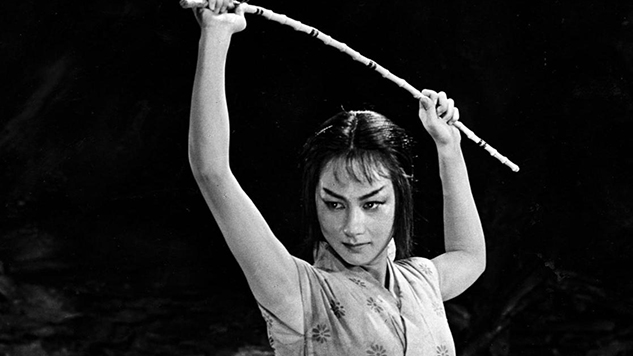
Elephant in the room: The Hidden Fortress is one of the biggest, if not the biggest, inspirations for the original Star Wars. George Lucas was inspired by Kurosawa’s other Jidaigeki (the origin of the word “Jedi”) films when it comes to creating the technical frame of his blockbuster, but the narrative he lifted fairly liberally from The Hidden Fortress. Told from the perspective of two low-class characters, the good rebels vs. evil empire story represents an important tool in discovering the roots of Lucas’s saga. But this is far from an “eat your cinematic vegetables” situation: The Hidden Fortress, made as an effort by Kurosawa to present his audience with a fun, straight genre project as a “respite” from the more somber and introspective work that preceded it, is a roaring good time with a sprawling narrative and spectacular set pieces.
9. Red Beard (1965)
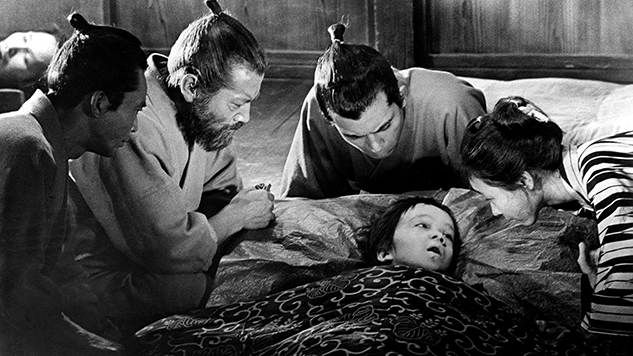
One of the recurring themes of Kurosawa’s dramatic work is compassion, namely how little of it exists in our world, and how much even a single individual can affect change for good with the simplest of deeds. Roger Ebert even wrote in his “Great Movie” review of Red Beard, “I believe this film should be seen by every medical student.” The story, a sprawling drama struck by black-and-white, widescreen cinematography, is centered on a young, self-important medical intern (Yuzo Kayama) learning to connect with his patients on a personal level, but not without the help of a small town doctor (Toshiro Mifune) with a dogged passion for healing the poor. The doctor, affectionately nicknamed Red Beard, doesn’t let anything stand between him and the opportunity to tend to a patient, even if it means kicking mucho gangster ass to do so. That sequence, the film’s sole martial arts set piece, also works as the clearest reminder of the film’s lesson of compassion being an omnipresent quality: After beating up the gangsters, Red Beard provides them with assistance in healing the wounds he created.
8. Stray Dog (1949)
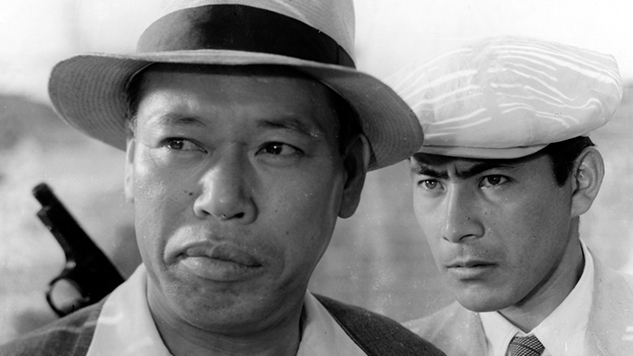
Stray Dog is the buddy cop mold: Hotshot young cop (Toshiro Mifune) is assigned to work with a patient, seasoned officer (Takashi Shimura) who’s close to retirement to track down a serial criminal who’s terrorizing the city. As a personal relationship forms, the young cop learns to respect procedure, while the old cop begins to lighten up. A personal tragedy, too, at the second act break gives the protagonist the drive to pursue the case even further, during a time when solving it becomes more and more unlikely. Despite its status as progenitor of such tropes, Stray Dog is still captivating thanks to the ever-reliable chemistry between Mifune and Shimura, the tight pacing and the film’s fascinatingly blunt depiction of the Tokyo crime world, grimy with noir.
7. Throne of Blood (1957)
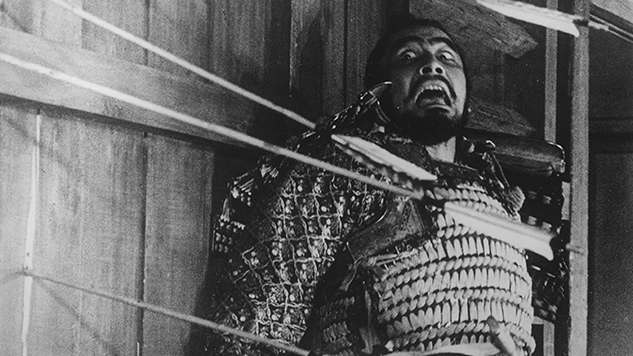
Hands down the greatest adaptation of Macbeth on the silver screen, Throne of Blood is as close as Kurosawa got to making a horror masterpiece. His reliance on the supernatural elements of Shakespeare’s tragedy in order to hammer home the inescapable hell that awaits his protagonist provides a deeply disturbing narrative, while the dark, guttural style of the Japanese Noh theater haunts every frame of the film. As such, Throne of Blood serves as bridge between western and Japanese storytelling sensibilities. It also contains one of the most meticulously mannered performances of Toshiro Mifune’s career. His take on Macbeth, who’s a paranoid general named Washizu in this version, is brimming with sadness behind a ruthless façade, unable to turn the tides against his bleak destiny.
6. Ran (1985)
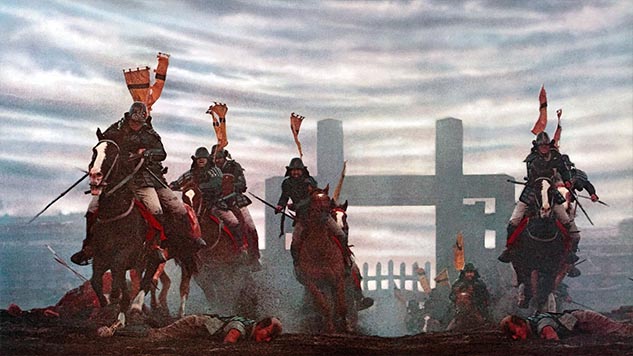
A quintessential Kurosawa epic with the grandest of visions, supported by exhilarating color cinematography and some of the most breathtaking battle sequences ever committed to film, Ran is, like Throne of Blood, another Shakespeare adaptation, this time a fairly loyal take on King Lear. Compared to the morbidly dark and personal Throne, Ran is a lavish visual feast, deftly depicting an old warlord’s (Tatsuya Nakadai in maybe the greatest performance of his career) fall from glory at the hands of his greedy and selfish sons, who are really only responding to their father’s ruthless rule. The circle of human fallacy and cruelty continues.
5. High and Low (1963)
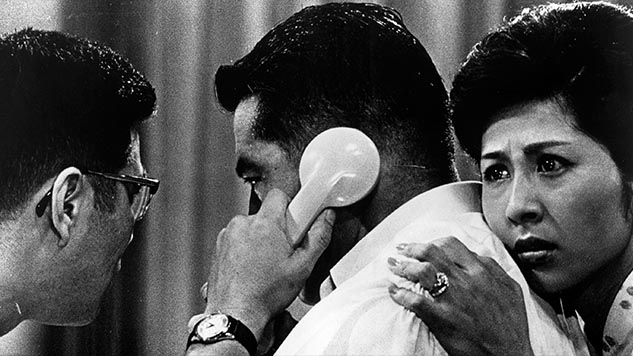
In the case of High and Low, pretty much any procedural that’s centered on a kidnapping, from Ransom to episodes of Law & Order, can trace their roots back to this impeccably executed and tightly-wound adaptation of Ed McBain’s novel, King’s Ransom. Kurosawa skillfully splits his film into two distinct sections, the first an intense chamber drama about a shoe mogul (again: Toshiro Mifune) who is pressured into paying the ransom to rescue his chauffeur’s son after the kidnapper snatches the wrong kid, and the latter a painstakingly detailed focus on the police’s hunt for the kidnapper. The most tension-filled ransom exchange sequence ever filmed works perfectly as the midpoint break between the two halves, which eventually begin to converge as a potent study on the psychological effects of income inequality disguised as a straight genre piece.
4. Rashomon (1950)
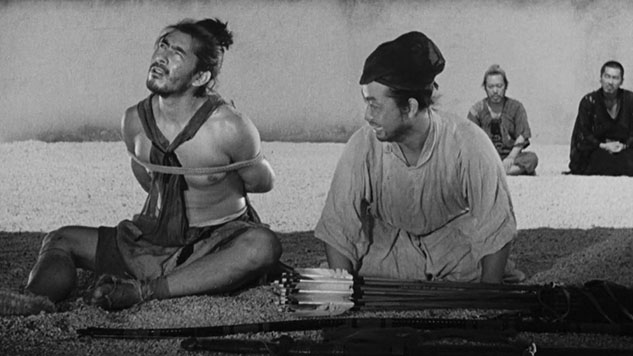
Rashomon digs into the inherent unreliability of any storyteller, attempting to find the ultimate truth within a set of facts and instead realizing that’s an almost impossible challenge. After a murder occurs, the three witnesses (played by Toshiro Mifune [of course], Machiko Kyoto and Masayuki Mori) to the crime each give their version of what transpired to a judge—including the murder victim, who communicates through a medium in one of the most deliciously subversive scenes in Kurosawa’s filmography. Each version of the story follows pretty much the same beats, but the truth behind the facts are altered by the way each narrator makes him- or herself look heroic while villainizing the other two. What you get out of Rashomon, what you believe to be the truth, depends not on the storyteller, but on your own beliefs and prejudices.
3. Yojimbo (1961)
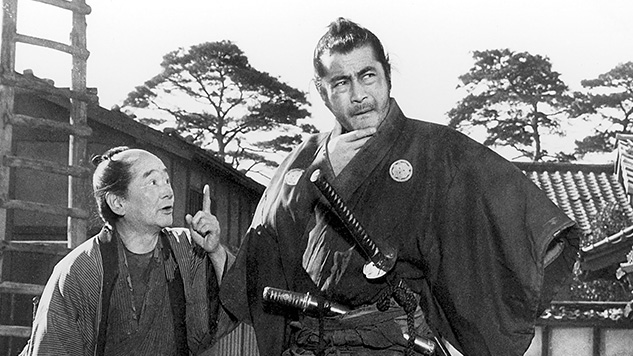
A usually nameless, gruff but charming anti-hero strolls into a crime-ridden hellhole, helping poor denizens out of selfish reasons at first, but gradually reveals his long-hidden compassion to sacrifice his life for the greater good. Every post-1964 western ever made, every gritty superhero movie of the last three decades, an installment of the Mad Max franchise—it all owes some due to Kurosawa’s immensely entertaining and flawlessly executed badass samurai flick. Toshiro Mifune, in his most effortlessly charismatic turn on screen, plays a mysterious ronin who manipulates both sides of a war between two rival criminal families both terrorizing a small town. Will he destroy them all, or perish in the process? With its cool jazzy score, widescreen framing that uses the negative space to its full advantage and a patient rhythm that finds just as much excitement out of the quiet moments as it does when the swords start clashing, Yojimbo first proved that a “western” need not be tied to the West.
2. Ikiru (1952)
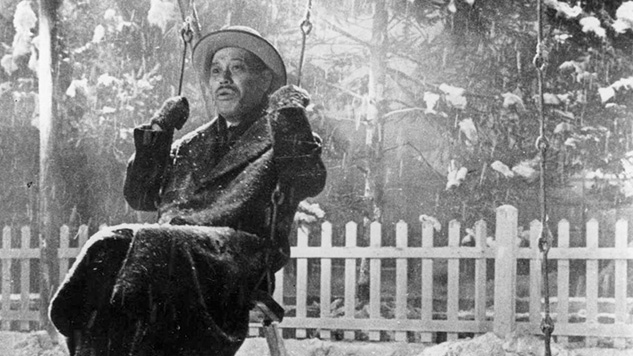
Ikiru translates to English as “to live”—whatever that means. As our unseen narrator introduces us to the protagonist of our story, Kenji Watanabe (Takashi Shimura), a boring and reserved, insignificant bureaucrat buried under a graveyard of paperwork, stomach cancer works through Watanabe’s frail body. The tragic news propels Watanabe to finally live life to the fullest, but how can someone who’s been already dead inside for decades suddenly flip a switch and allow the sheer exhilaration of existence to enter his withered soul? With this profoundly touching drama, Kurosawa creates a purely human cinematic experience, driven by Shimura’s honesty and vulnerability. Just witness the deep pain he exudes during an iconic sequence wherein he suddenly starts singing in a nightclub.
1. Seven Samurai (1954)
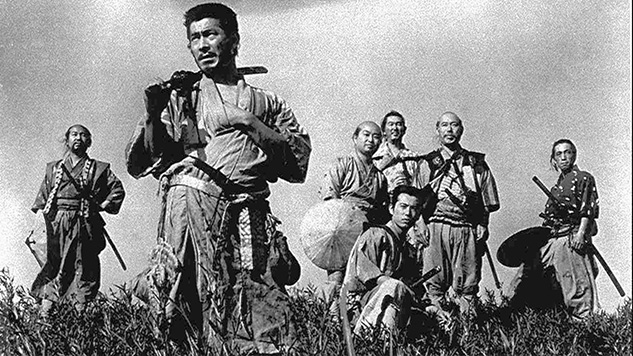
The heart’s favorite Kurosawa film is Ikiru, while the brain’s is always dead-set on Seven Samurai. Forget the myriad of official and unofficial remakes and re-imaginings, just think of practically any ambitious action/adventure yarn, of rousing tales of underdogs battling seemingly unbeatable forces threatening the underdog existence with only bravery, wits and bravado on their side: Seven Samurai is built into that DNA. From the smallest details of its structure, right down to specific framing, design and choreography, Kurosawa’s choices solidify it as easily one of the greatest films ever made.